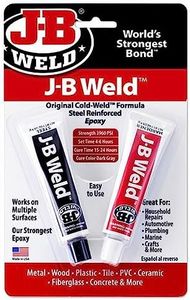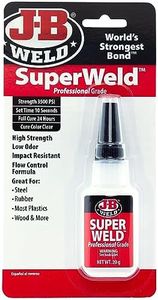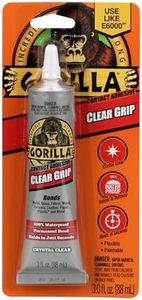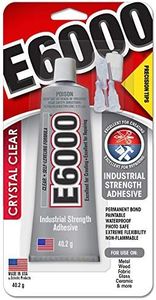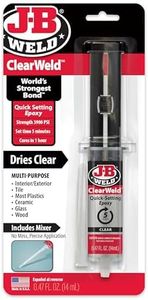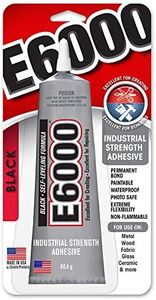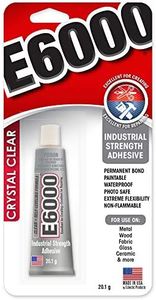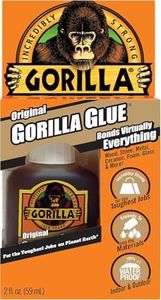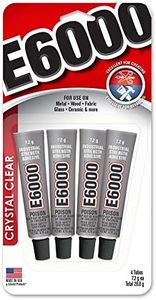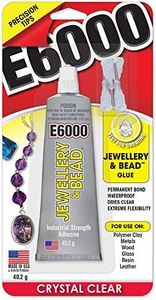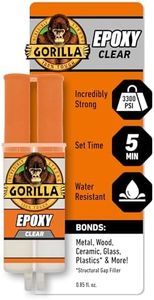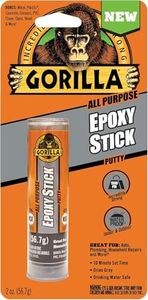We Use CookiesWe use cookies to enhance the security, performance,
functionality and for analytical and promotional activities. By continuing to browse this site you
are agreeing to our privacy policy
10 Best Glue For Ceramic Mug
From leading brands and best sellers available on the web.Buying Guide for the Best Glue For Ceramic Mug
Choosing the right glue for a ceramic mug is essential to ensure a strong and lasting bond. Whether you're repairing a broken handle, reattaching a decorative element, or fixing a crack, the glue must be compatible with ceramics and safe for use on items that may come into contact with food or drink. It's important to think about how you'll use the mug after it's fixed, such as whether it needs to withstand washing or exposure to heat. Understanding the specific features of glues will help you pick the best one for your needs.Bond StrengthBond strength refers to how powerfully the glue holds the broken pieces together once it cures. This is crucial for ceramic mugs, as the glued section must be durable enough to handle daily use and exposure to liquids. Glues are usually marked as ‘light,’ ‘medium,’ or ‘heavy-duty’ in terms of strength. Light strength might suit minor chips, medium strength works for cracks, while heavy-duty adhesive is best for reattaching handles or structural fixes. If your mug will bear weight or be frequently handled, always opt for a glue labeled as heavy-duty to ensure it stays together.
Water ResistanceWater resistance determines how well the glue holds up when the mug is washed or gets wet. Glues can be non-waterproof, water-resistant, or fully waterproof. If the mug will only be decorative and never washed, water resistance is less critical. But for functional mugs that will be rinsed or go in the dishwasher, choose a glue specifically marked as waterproof. This ensures the repair won’t weaken or come apart over time due to moisture exposure.
Heat ResistanceHeat resistance addresses whether the glued joint can withstand the temperatures encountered when pouring in hot drinks or during washing. Glues vary: some can't handle heat at all, while others can withstand temperatures up to certain limits (often listed on the packaging). If you plan to use the mug for hot beverages, choose a glue rated for high temperatures, commonly described as ‘heat-resistant’ or listing a temperature threshold of at least 100°C. For purely decorative mugs, heat resistance is less important.
Food SafetyFood safety ensures that the glue does not leach harmful chemicals if it comes into contact with drinks or food. Only some glues are labeled ‘food-safe’ or ‘FDA approved for food contact.’ This is especially important if the glue will be exposed on the inside of the mug or near areas that touch your mouth or beverage. For mugs that will be used for drinking, always pick a food-safe adhesive; for strictly decorative repairs, this feature is less critical.
Drying/Curing TimeDrying or curing time is how long it takes for the glue to set fully. Some glues set in minutes, while others may need hours or even a day to achieve maximum strength. Fast-setting glues are convenient for small chips or quick fixes, but for strong bonds—especially on stressed parts like handles—longer curing times can indicate a stronger, more durable repair. If you want to use the mug quickly, look for fast-drying options, but for the strongest repair, it's often better to allow full curing time.
Transparency After DryingTransparency after drying refers to whether the glue dries clear or leaves a visible residue. Clear-drying adhesives are preferred for visible repairs to maintain the mug's appearance. Colored or opaque glues may be noticeable and affect aesthetics. If the glue line will be exposed or you want an invisible repair, choose a glue labeled as ‘clear drying.’ If the area is hidden, this may matter less.
Ease of ApplicationThis refers to how easy the glue is to apply and control. Some glues are runny or messy, while others come with applicator tips or are gel-like and stay put. For small, precise repairs, a glue with a fine applicator or thicker consistency gives more control and avoids mess. If you’re repairing a large or less precise break, standard applicators may suffice. Your comfort with handling materials and the size of the repair should guide you here.
